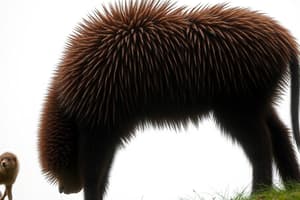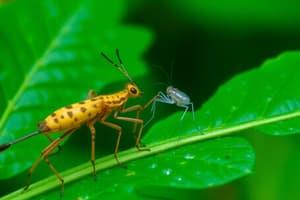Podcast
Questions and Answers
What is reproductive isolation?
What is reproductive isolation?
Which mechanism of reproductive isolation occurs due to differences in mating preferences?
Which mechanism of reproductive isolation occurs due to differences in mating preferences?
What is the purpose of prezygotic isolation?
What is the purpose of prezygotic isolation?
How does temporal isolation contribute to reproductive isolation?
How does temporal isolation contribute to reproductive isolation?
Signup and view all the answers
Which type of isolation involves differences in morphology?
Which type of isolation involves differences in morphology?
Signup and view all the answers
What role does reproductive isolation play in speciation?
What role does reproductive isolation play in speciation?
Signup and view all the answers
Which of the following represents postzygotic isolation?
Which of the following represents postzygotic isolation?
Signup and view all the answers
What environmental factor can lead to populations developing unique traits and diverging?
What environmental factor can lead to populations developing unique traits and diverging?
Signup and view all the answers
How do geographic barriers contribute to reproductive isolation?
How do geographic barriers contribute to reproductive isolation?
Signup and view all the answers
What is a result of hybrid dysgenesis in species hybrids?
What is a result of hybrid dysgenesis in species hybrids?
Signup and view all the answers
Why is understanding speciation and reproductive isolation important?
Why is understanding speciation and reproductive isolation important?
Signup and view all the answers
What role does speciation play in the diversification of life on Earth?
What role does speciation play in the diversification of life on Earth?
Signup and view all the answers
Study Notes
Understanding Speciation and Reproductive Isolation
Speciation, the process by which new species arise from pre-existing ones, is a fundamental concept in biology that sheds light on the rich diversity of life on our planet. In this exploration, we'll delve into the mechanisms of speciation, focusing on the role of reproductive isolation.
Defining Speciation
Speciation occurs when a group of individuals descended from the same ancestral species becomes genetically isolated from one another to the extent that they are no longer capable of producing fertile offspring if they interbreed. Over time, these distinct groups may evolve independently, acquiring unique traits and eventually constituting separate species.
Reproductive Isolation
Reproductive isolation, also known as prezygotic or postzygotic isolation, is a key mechanism that enables speciation. Reproductive isolation refers to the lack of successful reproduction between two populations that would otherwise be capable of interbreeding.
-
Prezygotic isolation occurs before the formation of a zygote (a fertilized egg) and can be achieved through various means:
- Temporal isolation: The two populations breed at different times of the year.
- Behavioral isolation: Mating preferences, courtship rituals, or mating systems may differ between populations.
- Mechanical isolation: Differences in morphology, such as size or shape, can prevent individuals from two populations from mating.
- Environmental isolation: Physical barriers like rivers, mountains, or varying habitats may prevent individuals from meeting and mating.
-
Postzygotic isolation occurs after the formation of a zygote and can lead to the production of sterile or unviable offspring:
- Genetic incompatibilities: Differences in the genetic makeup of the two populations may result in non-viable offspring or reduced fertility.
- Hybrid dysgenesis: The potential for species hybrids to exhibit inferior traits or suffer from developmental defects.
Drivers of Reproductive Isolation
Reproductive isolation can arise from various factors, including:
- Environmental pressures: Adaptive radiation, natural selection, and environmental fluctuations may cause populations to diverge and develop unique traits.
- Geographic barriers: Physical barriers such as mountains, rivers, or vast distances may prevent gene flow between populations.
- Competition: Competition for resources or mates may drive populations to adapt and evolve distinctive traits.
- Predation and parasitism: Co-evolutionary interactions between species may lead to the development of unique traits that confer an advantage in avoiding predators or parasites.
Diversity of Species
Speciation and reproductive isolation play a pivotal role in the diversification of life on Earth. As species continue to evolve and diverge, new species arise, contributing to the remarkable variety of life we observe today.
Conclusion
Understanding speciation and reproductive isolation is essential for grasping the complex interplay between genetic and environmental factors that shape the evolution of life on our planet. The mechanisms of speciation and reproductive isolation not only illuminate the fascinating process by which new species arise but also provide valuable insights into the conservation and management of biodiversity in the face of habitat loss and climate change.
Studying That Suits You
Use AI to generate personalized quizzes and flashcards to suit your learning preferences.
Description
Dive into the mechanisms of speciation and reproductive isolation in biology. Explore how new species arise through genetic isolation, prezygotic and postzygotic barriers, and the drivers of reproductive isolation. Gain insights into the diverse factors contributing to the evolution and diversity of life on Earth.




